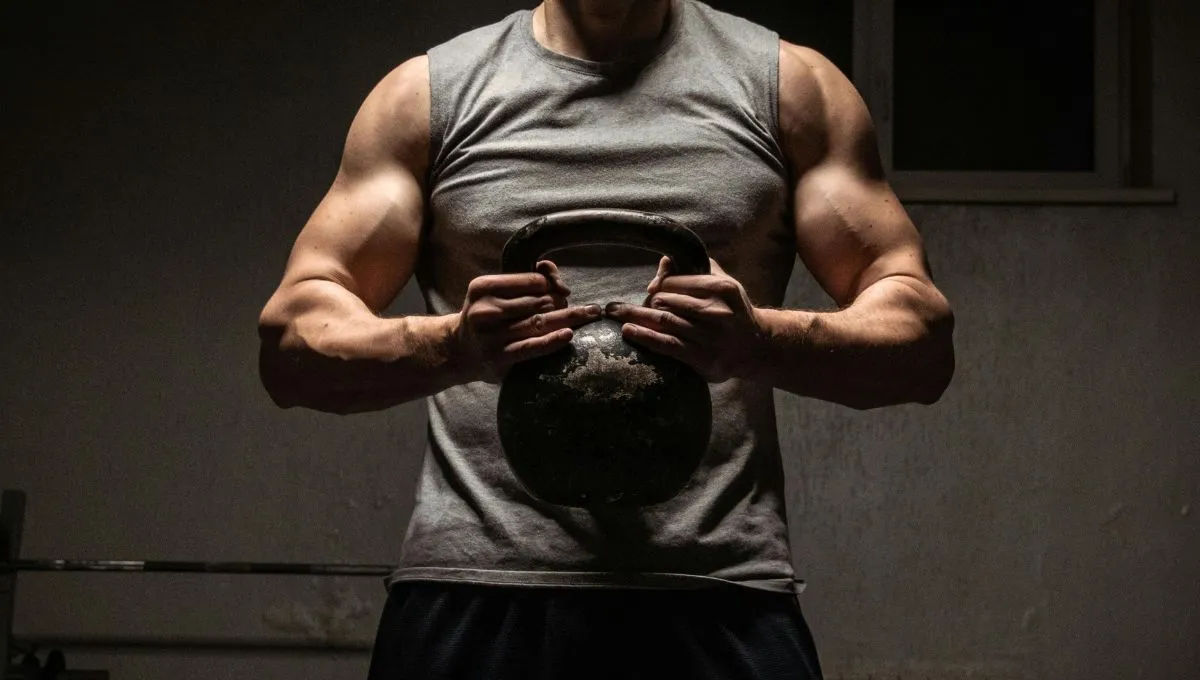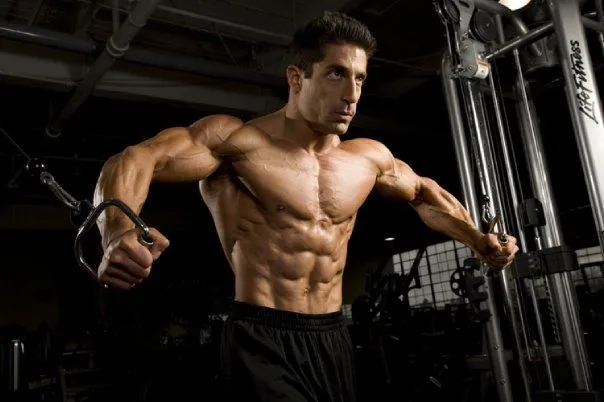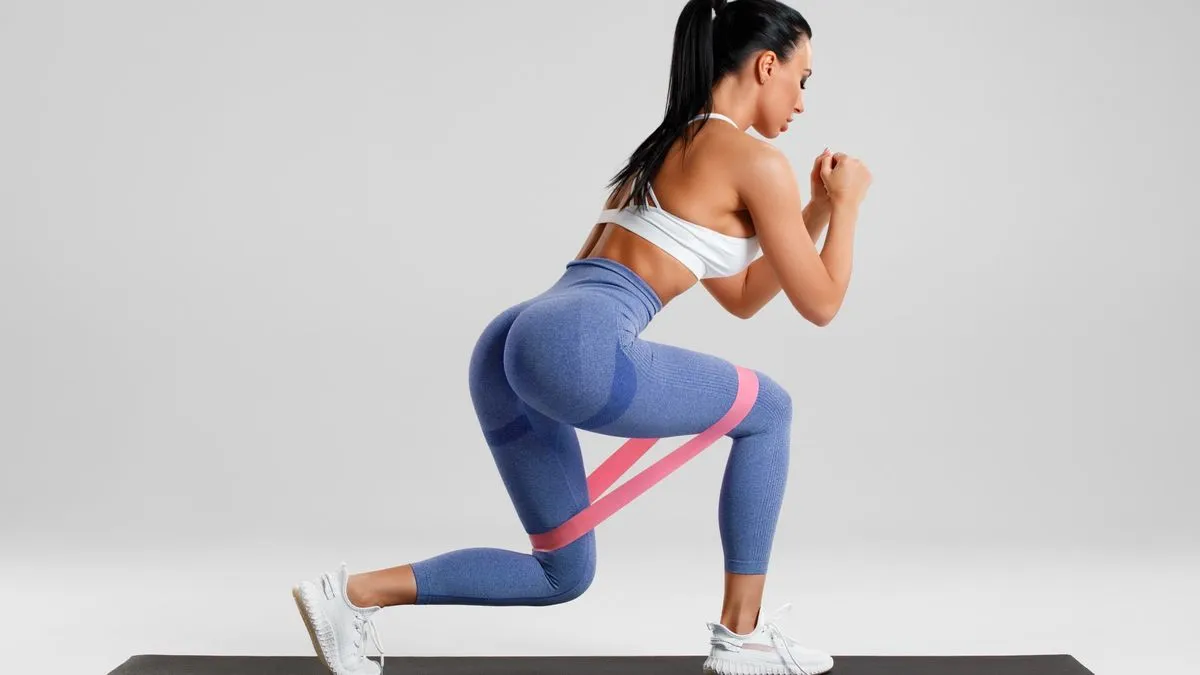Build Stronger, Bigger, Pain-Free Shoulders: The Best Shoulder Exercises
May 28, 2025
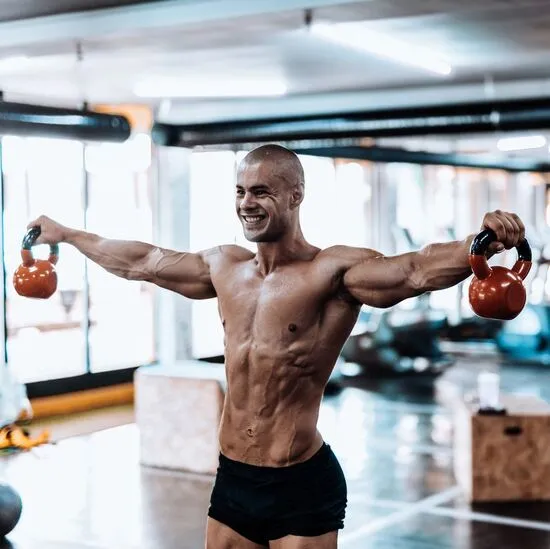
A strong set of shoulders does more than fill out a shirt. They support almost every upper body movement, from pressing weights overhead to pulling rows or controlling a barbell on chest day. That’s why including the best shoulder exercises in your routine is essential. Whether you're lifting for strength, muscle size or better posture.
Shoulder training often takes a backseat to chest days or back workouts, but well-rounded lifters know better. A smart shoulder workout for mass and definition includes more than just pressing movements. It targets all three heads of the deltoid: front, side and rear. With exercises that challenge different angles and ranges of motion.
By focusing on shoulder exercises for stability and strength, you protect your joints, support your lifts, and reduce injury risk. A solid shoulder training routine makes overhead movements feel easier and adds power to other lifts like the bench press and deadlift. If you're working on a complete upper body program, your delts deserve their own time and attention.
From barbell presses to dumbbell shoulder workouts and mobility-focused drills, training your shoulders with purpose brings real results. The right combination of exercises will help you build shoulder strength, improve definition, and unlock new levels of control and performance in and out of the gym.
Exercises for Bigger Shoulders
- Compound Shoulder Exercises for Full Development
- Isolation Shoulder Exercises for Muscle Definition
- Posterior Deltoid and Trap Focused Shoulder Exercises
- Functional and Stability Based Shoulder Exercises
- Best Shoulder Exercises You Can Do at Home
- Prehab and Mobility Focused Shoulder Exercises
- Tips for an Effective Shoulder Workout Routine
- Frequently Asked Questions About Shoulder Exercises
- Train Smart, Press Strong, and Build Shoulders That Last
Compound Shoulder Exercises for Full Development
Barbell Overhead Press
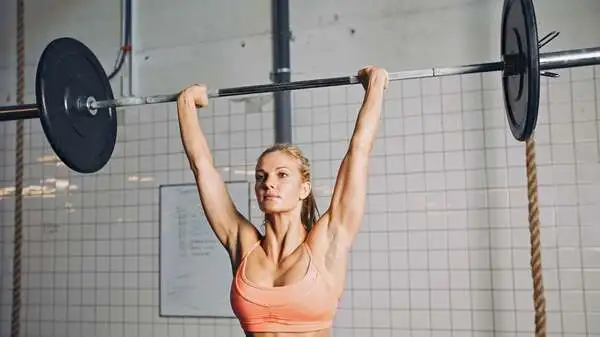
The barbell overhead press is a foundational shoulder exercise for strength, size and control. It’s one of the most effective compound shoulder exercises because it works not only the deltoids but also the triceps, upper chest and core. If your goal is to build upper body mass and develop pressing power, this movement should be a regular part of your routine.
To perform the barbell overhead press correctly, begin by racking the barbell at about chest height. Grip the bar just outside shoulder width, keeping your wrists straight and elbows slightly in front of the bar. Step back with feet shoulder width apart, brace your core, and press the bar directly overhead until your arms are locked out. Lower the bar slowly to the starting position under control.
This exercise primarily targets the anterior (front) deltoids, but the lateral delts, upper traps and triceps are heavily involved. Because you're lifting the weight in a vertical path, your entire shoulder complex works to stabilize the movement. That’s why it’s one of the best shoulder exercises for improving posture, core strength and shoulder stability.
Adding the overhead press to your shoulder workout for strength builds a strong foundation for lifts like the push press or incline bench press. Use moderate to heavy weight for low to mid reps (4–8) and always focus on proper form. A strong press carries over into other lifts and helps prevent shoulder imbalances down the line.
Seated Dumbbell Shoulder Press
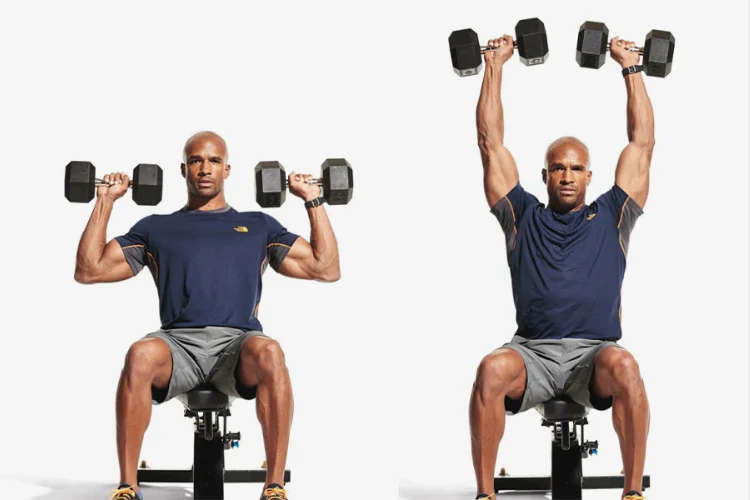
The seated dumbbell shoulder press is a go-to move for anyone looking to isolate the deltoid muscles and safely build upper body strength. Unlike its barbell counterpart, using dumbbells allows each arm to move independently, which can correct muscle imbalances and enhance overall shoulder symmetry. This makes it one of the best deltoid exercises for balanced development and control.
Start by sitting on a bench with back support and holding a dumbbell in each hand at shoulder level. Palms should face forward or slightly inward, depending on your comfort. Press the dumbbells overhead in a smooth, arcing motion until your arms are fully extended but not locked out. Lower them slowly back to shoulder height, keeping tension in the muscles the entire time.
This movement primarily targets the anterior and lateral heads of the deltoids, with secondary involvement from the triceps and upper chest. Because you're seated, your lower back and core remain more stable, allowing you to focus on a strict and controlled pressing movement. It’s ideal for lifters rehabbing from injury or anyone prioritizing safe shoulder strength training.
Including this in your dumbbell shoulder workout routine enhances muscle activation and helps with shoulder hypertrophy. For best results, use moderate weights and aim for 8 to 12 reps, focusing on perfect dumbbell shoulder press form. Controlled reps lead to better results and lower injury risk.
Standing Military Press
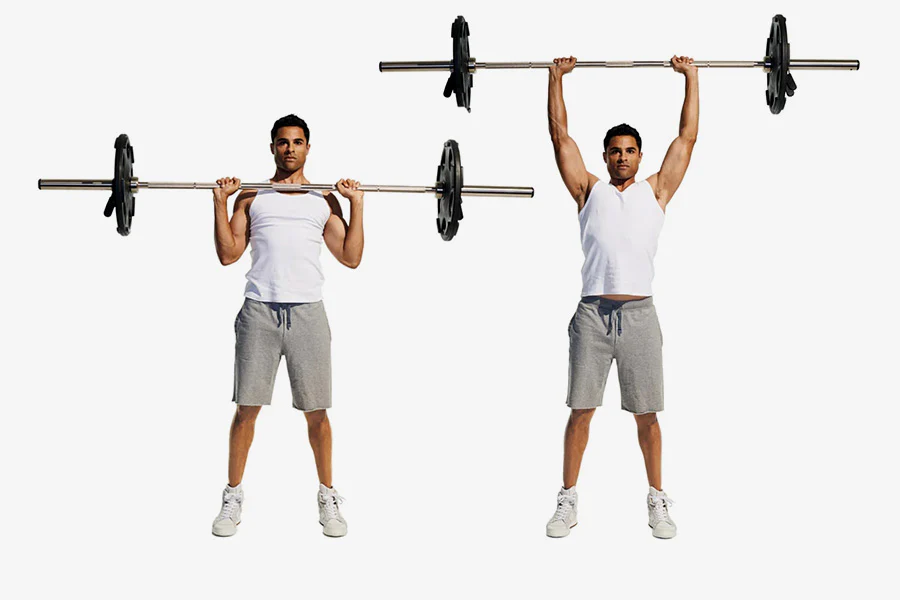
The standing military press is a classic overhead strength exercise that demands strict form and full-body coordination. Unlike push presses or seated presses, this variation is done standing, with feet together and no leg drive, which increases the challenge on your shoulders and core. It’s a shoulder pressing variation that builds strength, stability and control.
To perform it, start by unracking the barbell from shoulder height. Your grip should be just wider than shoulder width, with elbows slightly in front of the bar. Stand tall with your feet close together, brace your core, and press the bar overhead in a straight line. Pause briefly at the top before lowering the bar slowly to your upper chest.
This movement primarily targets the anterior deltoids, but also works the lateral delts, triceps, traps and stabilizing core muscles. Because of the narrow stance and strict posture, the standing military press forces you to engage your entire upper body without relying on momentum. That makes it ideal for lifters looking to develop upper body control and shoulder discipline.
Military press benefits go beyond muscle size. It enhances posture, builds static strength, and improves control in overhead movements like handstands or Olympic lifts. As part of a standing shoulder workout, it’s a reliable way to push your limits while reinforcing great technique. Start with lighter weight to learn the movement, then progress as your form stays solid.
Push Press
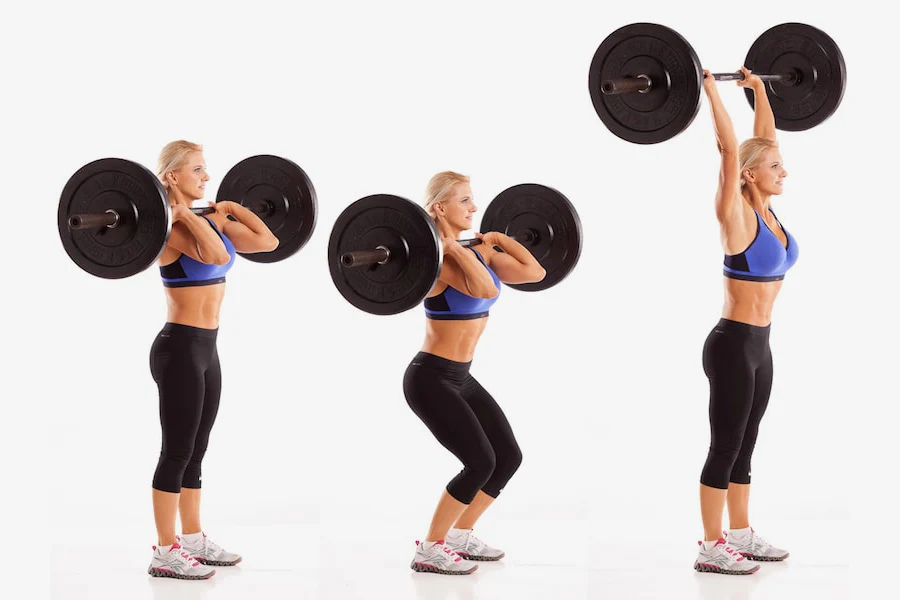
Push press is a dynamic shoulder exercise that builds explosive power and trains the body to move with strength and speed. Unlike strict pressing variations, this total body pressing movement uses leg drive to help launch the weight overhead. That makes it an excellent choice for athletes or lifters focused on functional shoulder training.
Begin with a barbell racked at your shoulders and your feet shoulder width apart. Keep your core tight, bend your knees slightly and drive upward using your legs and hips. As the bar begins to move, press it overhead in one fluid motion until your arms are fully extended. Control the descent back to the starting position and reset before the next rep.
This explosive shoulder workout works more than just the deltoids. It heavily involves the quads, glutes, calves and triceps, while also demanding balance and timing. The primary shoulder muscle activated is the front deltoid, with additional support from the lateral delts and upper back.
Push press is one of the best dynamic overhead lifts for building athletic shoulder strength and increasing force output. It bridges the gap between raw strength and speed, making it a top pick for sports performance or anyone looking to build functional shoulder power. Use it early in your workout for lower reps and heavier weight to maximize its benefits.
Isolation Shoulder Exercises for Muscle Definition
Dumbbell Lateral Raise
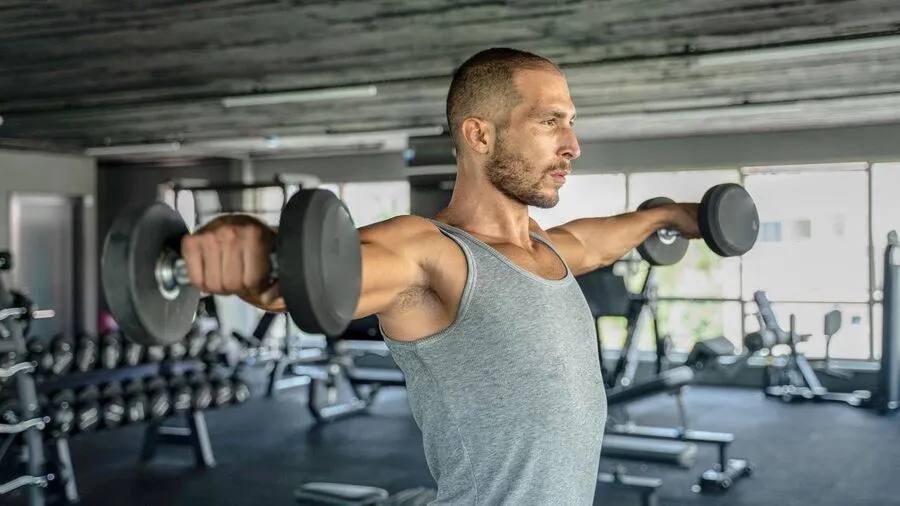
Dumbbell lateral raises are one of the most effective isolation shoulder movements for building shape and width in your upper body. This exercise specifically targets the lateral deltoid head, which plays a major role in creating broad, rounded shoulders. If your goal is to build side delts and define shoulder width, this move belongs in your routine.
Start by holding a dumbbell in each hand with a slight bend in your elbows. Stand tall, keep your chest up, and raise both arms out to the sides until they reach shoulder height. Pause briefly, then lower the weights slowly back to your sides under control. The key here is not using momentum; slow, controlled motion activates the deltoids more effectively.
This dumbbell shoulder isolation drill works best with moderate to light weights and higher reps. The focus is on creating time under tension rather than lifting heavy. Because it directly targets the side of the shoulder, it's also one of the best shoulder exercises for aesthetics and shaping your upper body silhouette.
Add lateral raises to your shoulder workout routine to complement pressing movements and ensure balanced deltoid development. Pairing them with rear delt and front delt exercises can help you build a more complete and defined upper body.
Dumbbell Front Raise

The dumbbell front raise is a focused isolation lift that targets the anterior deltoid. The front portion of your shoulder. It’s a staple in any shoulder workout for front delts, especially if you're working to improve overhead pressing strength or refine upper body symmetry. This movement emphasizes control and isolation over heavy lifting, making it ideal for shaping and defining the front of the shoulder.
To perform it correctly, stand with feet shoulder width apart and hold a dumbbell in each hand in front of your thighs. Keep your arms straight but not locked. Slowly raise the dumbbells in front of you to about eye level, keeping your palms facing down. Pause at the top, then lower the weights under control to the starting position.
This anterior deltoid exercise works best with moderate weight and deliberate form. Because the front shoulder can get plenty of indirect work during bench press and overhead movements, the goal here is targeted activation. It’s an excellent front shoulder activation drill that can correct strength imbalances and support more complex compound lifts.
Incorporating front raises into your weekly routine adds balance to your shoulder program and helps build detail and shape across your upper body. Rotate them with lateral and rear delt movements for complete development.
Rear Delt Fly (Reverse Fly)
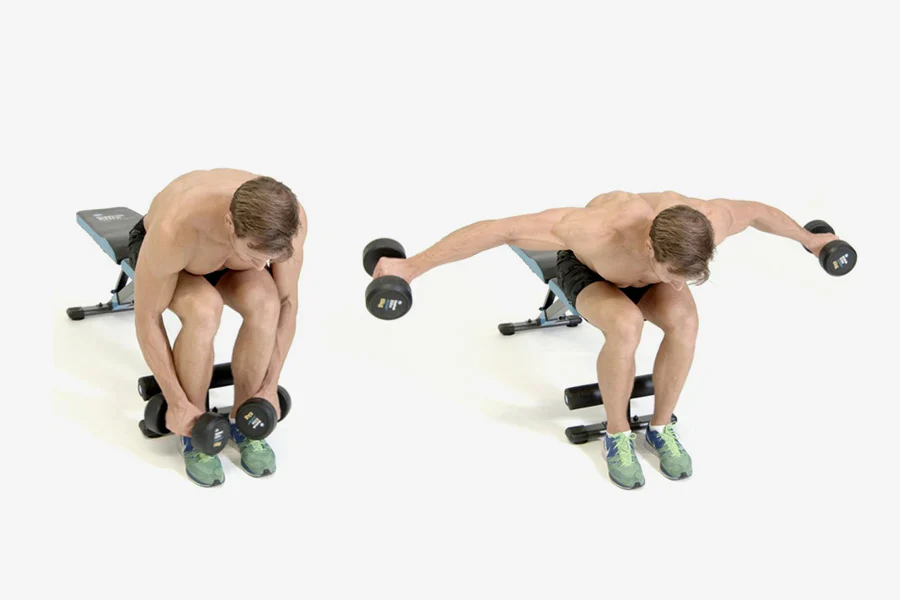
The rear delt fly is a go-to isolation exercise for targeting the posterior deltoids, the often overlooked muscles on the back side of your shoulders. Including this movement in your routine helps balance out front-heavy pressing work and contributes to better posture and upper body alignment. It’s one of the best shoulder and upper back isolation exercises for anyone looking to train smarter and more symmetrically.
To perform the reverse fly, start by holding a pair of dumbbells and bending at the hips with a flat back. Let your arms hang below you with a slight bend in the elbows. From there, raise your arms out to the sides in a wide arc, squeezing your shoulder blades together at the top of the motion. Lower with control and repeat for moderate to high reps.
This posterior deltoid workout not only builds rear delt strength but also improves scapular control and shoulder joint stability. It’s especially important for lifters who do a lot of bench pressing or overhead movements, which can overdevelop the front of the shoulders if not balanced properly.
Add the rear delt fly to your training to round out your shoulder development and reduce the risk of injury. For best results, keep the weights light to moderate, focus on perfect form, and aim for full range of motion. Reverse fly form tips like maintaining tension at the top and avoiding momentum will make a noticeable difference over time.
Cable Lateral Raise
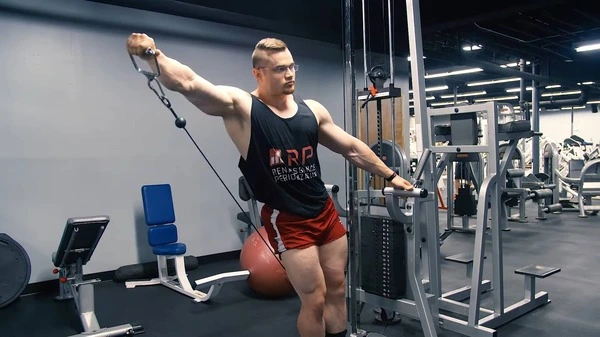
Cable lateral raise is a staple in shoulder training routines focused on aesthetics and precision. It’s one of the best cable shoulder exercises for lifters who want to shape side delts without overloading the joints. By using a cable machine, the resistance remains steady throughout the entire motion, making it a true constant tension movement that maximizes muscle engagement from start to finish.
To perform this lateral deltoid isolation exercise, stand beside a low cable pulley and grip the handle with your outside hand. Keep your arm slightly bent, your core engaged and your posture tall. Raise your arm out to the side until it's parallel with the floor, then slowly return to the starting position. Moving with control rather than speed ensures that the lateral head of your deltoid stays under tension the entire time.
This movement is excellent for lifters looking to refine shoulder width. It directly targets the side of the shoulder to help sculpt symmetrical shoulders and improve overall shoulder aesthetics. The continuous resistance from the cable adds depth to your training and allows you to make the most of every rep. Even with lighter weight.
If your goal is to build well-rounded delts and improve definition across all three heads, cable lateral raises deserve a regular place in your routine. Combine them with compound lifts and rear delt work to create a complete shoulder development program.
Posterior Deltoid and Trap Focused Shoulder Exercises
Face Pulls

Face pulls are one of the most effective movements for rear deltoid activation and overall shoulder health. Often overlooked in standard shoulder routines, this exercise focuses on strengthening the muscles of the upper back, traps and rotator cuff. Key areas for long-term joint integrity and posture support.
Set up by attaching a rope handle to a high pulley on a cable machine. Stand back a few steps, grab the ends of the rope with your thumbs facing down, and pull the rope towards your face while flaring your elbows wide. Squeeze your shoulder blades together at the peak of the movement before slowly returning to the start.
This exercise targets the rear delts, rhomboids, and the smaller stabilizers that support your shoulder joint. It’s particularly useful in any upper back and rotator cuff workout because it strengthens areas that often go undertrained. As a shoulder rehab movement, face pulls are also a favorite among physical therapists for improving scapular function and reducing pain.
Including face pulls in your weekly plan helps improve posture through training by pulling the shoulders back and countering the effects of too much chest pressing. Use moderate resistance and focus on smooth, controlled reps. Mastering proper cable rope face pull technique makes a big difference in long-term shoulder stability and muscle balance.
Reverse Pec Deck Machine
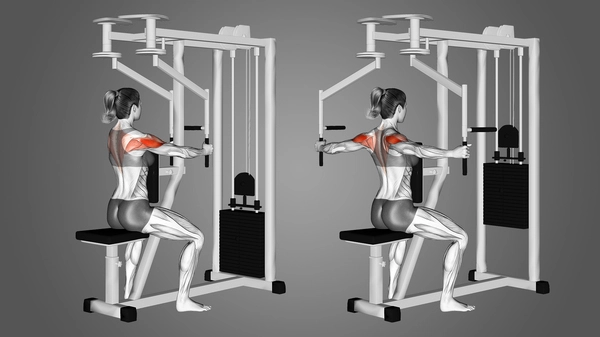
The reverse pec deck machine is a reliable and controlled way to isolate rear deltoids and develop upper back muscles. It's a great tool for lifters who want to sharpen their posterior shoulder strength training without relying on free weights. This movement keeps tension on the target area throughout the entire range of motion, making it ideal for those focusing on muscle engagement and precision.
To begin, adjust the pec deck machine to the rear delt position with the handles behind you. Sit facing the pads with your chest against the support and your arms extended forward. Grip the handles and pull them out to the sides in a reverse fly motion, squeezing your shoulder blades together at the top. Slowly return to the start position while keeping your movements smooth and controlled.
This reverse fly machine workout specifically targets the posterior deltoids, rhomboids, and mid traps. By isolating these muscles, the exercise enhances shoulder stability and helps with posture correction. It is significant for those who spend long hours sitting or pressing forward in training. Mastering rear delt machine form ensures you're activating the right muscles without using momentum.
Including this machine-based movement in your shoulder exercise routine is perfect for creating a balanced look and strengthening neglected areas. Pair it with compound lifts and lighter rotator cuff drills to round out your program.
Dumbbell Shrugs
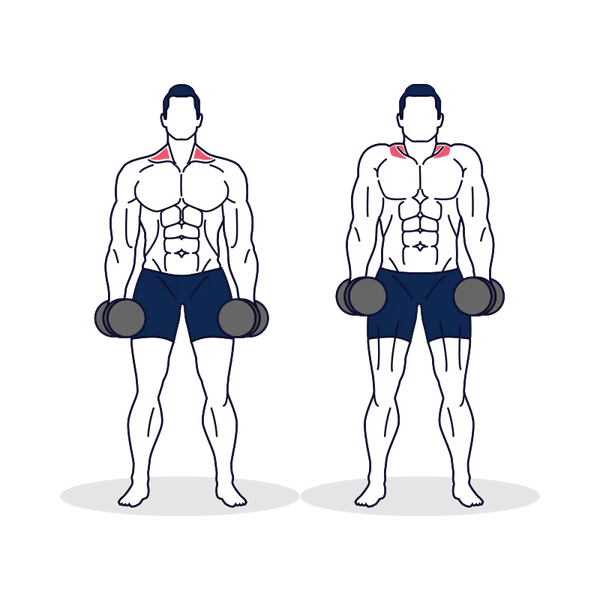
Dumbbell shrugs are a go-to movement for building the upper traps and enhancing the look of your shoulders and neck. This trap muscle workout is simple, effective, and ideal for lifters of all levels who want to elevate shoulder shape and add thickness to their upper frame. Because it's an isolation movement, proper form is everything.
Start by holding a pair of dumbbells at your sides with your arms straight and relaxed. Stand tall with your chest up and shoulders back. From there, shrug your shoulders straight up toward your ears, hold for a second at the top, then lower slowly. Avoid rolling your shoulders. Vertical movement is the goal for safe and effective upper trapezius isolation.
This shrug exercise primarily targets the upper trapezius but also supports overall neck and shoulder strength. Strengthening this area can help reduce tension and fatigue during heavy lifts like deadlifts or overhead presses. It’s a smart accessory movement that supports posture and adds to a broader upper body appearance.
Incorporate dumbbell trap builder sets into your routine 1–2 times a week using moderate to heavy weight. Focus on clean form and full range of motion. When done right, shrugs become a reliable finisher to any upper body or shoulder session, reinforcing strength and symmetry.
Functional and Stability Based Shoulder Exercises
Overhead Barbell Carry
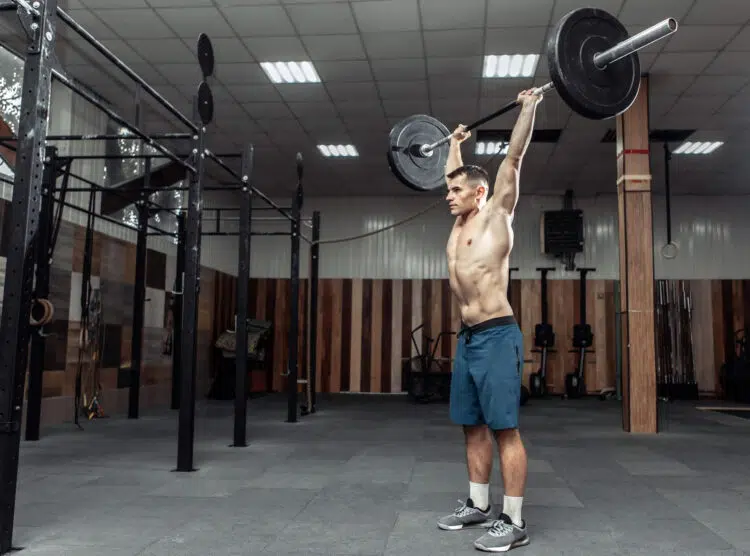
The overhead barbell carry is a unique shoulder exercise that challenges more than just your delts. This movement builds overhead stability, improves coordination, and forces your core and shoulders to work together. As a loaded carry shoulder exercise, it's excellent for developing functional strength and reinforcing total-body control.
To perform it, start by pressing a barbell overhead to a locked-out position with both arms. Once stabilized, begin walking forward slowly while keeping your core tight, elbows locked, and shoulders packed. Take short, controlled steps and keep the bar directly above your head throughout the drill.
This barbell overhead walking drill targets the deltoids, traps, triceps and stabilizing muscles throughout the core. It also improves balance and posture by teaching your body to stay upright under load. Unlike static lifts, this exercise forces shoulder and core integration as you move, making it a valuable addition to any overhead stability training plan.
Overhead carries are especially useful for athletes, lifters rehabbing from shoulder imbalances, or anyone looking to take their training beyond traditional pressing. Add this drill to finish off a push day or as part of your functional shoulder circuit.
Landmine Press
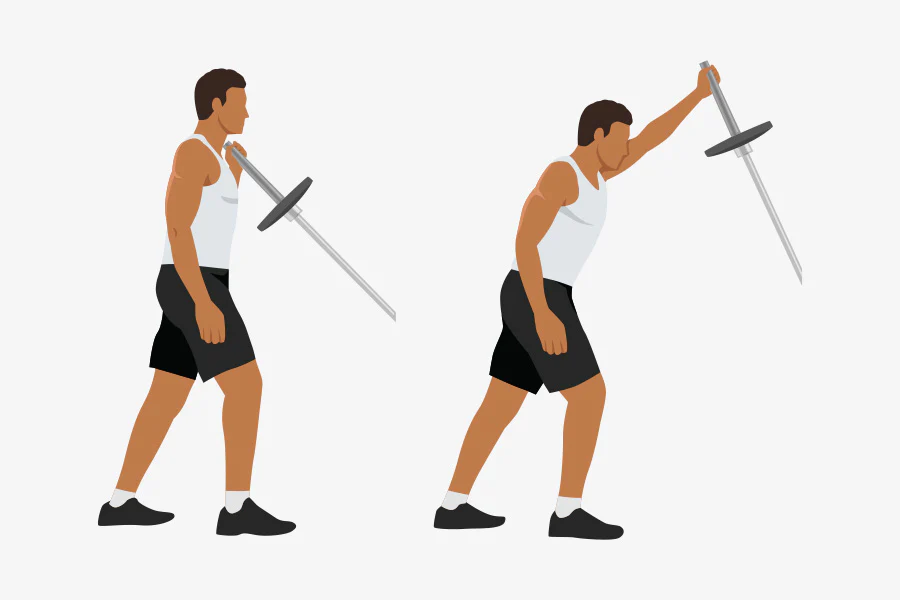
The landmine press offers a smart solution for anyone needing a more joint friendly shoulder exercise that still delivers results. This angled shoulder pressing movement uses a barbell anchored at one end, creating a unique arc of motion that reduces strain on the shoulder joint while still targeting the deltoids and triceps effectively.
To perform the exercise, insert one end of a barbell into a landmine attachment or secure corner. Load the opposite end with weight and hold it at shoulder level with one hand. Step slightly forward and press the bar up and away in a controlled arc until your arm is fully extended. Slowly bring it back down and repeat. Perform on both sides for balanced training.
This landmine shoulder workout hits the anterior deltoid primarily, while also engaging the upper chest, triceps and core. Because of the bar path and body position, it's a shoulder rehab pressing alternative that improves shoulder control and range without the joint compression of overhead barbell presses.
Add this movement into your training to build unilateral shoulder strength and refine stability. It’s especially helpful for lifters with mobility limitations or recovering from shoulder discomfort. Whether used as a primary lift or an accessory to overhead pressing, landmine presses deliver strength with safety.
Turkish Get-Up

The Turkish Get-Up is more than a shoulder exercise, it’s a full body shoulder stability drill that challenges coordination, control, and strength in one continuous movement. With just a kettlebell or dumbbell, you’ll engage nearly every muscle in your body while building overhead strength and shoulder integrity that translates into real world movement.
Start by lying on your back with a kettlebell held straight above your shoulder. Bend the knee on the same side, plant your foot flat, and use your opposite arm to support yourself as you rise. Move through a sequence of steps: propping to your elbow, shifting to your hand, lifting your hips, and swinging your leg under to come into a kneeling lunge, then stand fully upright. Reverse the motion to return to the starting position. Throughout, keep the weight stable and directly above your shoulder.
This dynamic functional shoulder movement targets the delts, rotator cuff, obliques, glutes and more. It builds overhead control and strength while also reinforcing total body awareness. Because of its complexity, the Turkish Get-Up is also one of the best drills for improving shoulder mobility and coordination. It is useful for athletes or anyone dealing with stiffness or imbalance.
Best Shoulder Exercises You Can Do at Home
Pike Push-Up
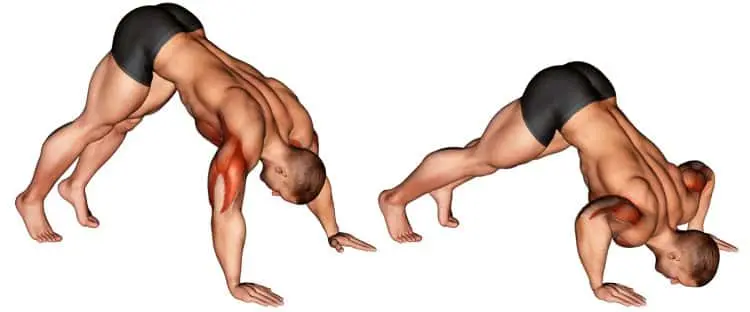
The pike push-up is a powerful bodyweight shoulder strength exercise that mimics the motion of an overhead press without needing any equipment. Perfect for at home shoulder workouts, it’s a vertical pressing movement that builds upper body muscle using just your own weight and gravity.
Start in a push-up position, then walk your feet closer to your hands and raise your hips toward the ceiling, forming an inverted V shape. Your head should be between your arms, eyes looking at your feet. From this position, bend your elbows to lower your head toward the floor, keeping your body tight and controlled. Press back up to the starting position and repeat.
This no gym overhead movement targets the anterior deltoids and upper chest, while also engaging the triceps and core. Because your body is moving in a more vertical line, you simulate the same motion used in traditional overhead presses. That makes it ideal for lifters who want to build shoulder mass using bodyweight, or those rehabbing from injuries who need low-impact pressing alternatives.
Pike push-ups are scalable. Start with feet flat on the floor and progress by elevating your feet for more resistance. Add them to your routine to improve shoulder and upper chest activation while developing stability and control all without stepping foot in a gym.
Resistance Band Shoulder Press
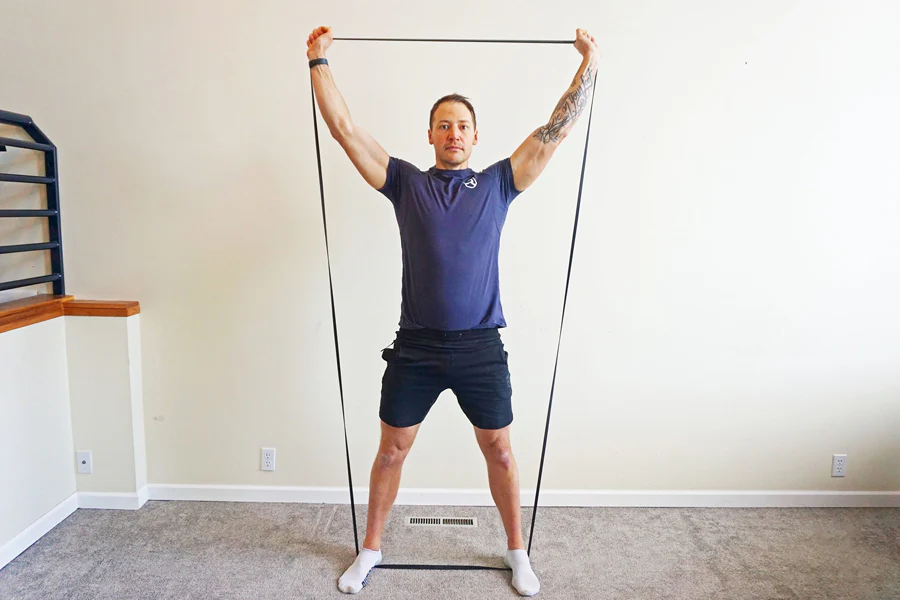
The resistance band shoulder press is a joint friendly alternative to traditional overhead lifting. It's a perfect shoulder workout with resistance bands for lifters training at home or anyone needing a low impact way to strengthen their delts. The smooth tension created by the band helps target the shoulders without placing heavy stress on the joints.
To perform the overhead resistance band press, step onto the middle of a long resistance band with feet shoulder width apart. Hold the handles or ends of the band at shoulder height with palms facing forward. Press straight up overhead, extending your arms fully, then return slowly to the starting position. Keep your core engaged and avoid arching your lower back.
This movement primarily activates the anterior and lateral deltoids, while also involving the upper traps and triceps. Because the resistance increases as the band stretches, the top half of the lift becomes especially challenging, helping to improve lockout strength and control. It's a great band press for deltoid development that can be done anywhere: home, park or hotel.
For those building a home shoulder training solution or looking to rehab their pressing pattern, this portable shoulder exercise option delivers excellent results. Use moderate tension bands and aim for higher reps to focus on muscle endurance and form refinement.
Wall Walks
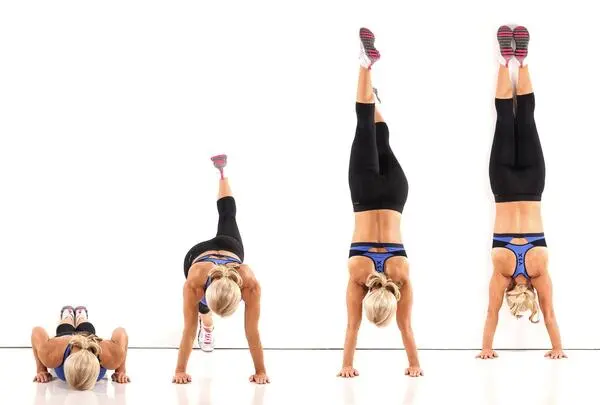
Wall walks are a challenging but effective bodyweight shoulder control drill that helps build strength, mobility and coordination at once. By combining full body tension with vertical movement, this exercise trains your deltoids, scapular stabilizers and core in a way that few other movements can. It’s a great option for lifters who want to improve overhead control without heavy weights.
To start, lie face down in a push-up position with your feet against a wall. Press up, then begin walking your feet up the wall as your hands walk closer toward the base. Continue walking until your chest nearly touches the wall and your body forms a vertical line. Pause briefly, then reverse the motion carefully to return to the floor.
This scapular stability shoulder movement lights up your entire upper body, especially the shoulders, traps and core. As a wall based shoulder training exercise, it builds overhead strength and control while also improving range of motion. Because of the body position, it forces your delts and core to coordinate together, making it an ideal core and deltoid coordination drill.
For athletes, climbers, CrossFitters and anyone training handstand progressions, wall walks are a must. They also function as a mobility drill, helping you build shoulder mobility and strength while reinforcing body awareness. Start slow, master the basics and work toward smoother, more controlled reps.
Prehab and Mobility Focused Shoulder Exercises
Scapular Wall Slides
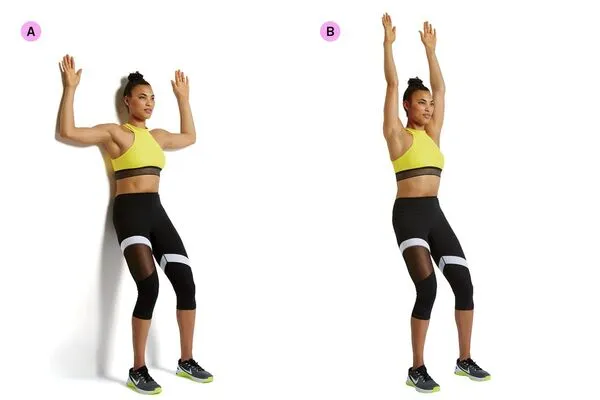
Scapular wall slides are one of the most effective shoulder mobility drills you can do with zero equipment. This simple-looking movement improves shoulder blade control, strengthens postural muscles, and enhances overhead range of motion. It's a low impact shoulder stability training tool that’s especially helpful for warm-ups, rehab, or anyone working to undo years of poor posture.
Start by standing with your back flat against a wall, feet a few inches forward, and your lower back pressed gently into the surface. Raise your arms up in a goalpost position with elbows bent at 90 degrees and the backs of your hands touching the wall. Slowly slide your arms upward, trying to keep your arms and hands in contact with the wall, then return to the start.
This shoulder blade activation movement trains the mid and lower traps, rhomboids, and rotator cuff muscles. It helps build coordination between the shoulder joint and scapula, which is essential for safe pressing and pulling. The wall slide for scapular control teaches your body to move with stability rather than compensation.
Incorporate this posture correction shoulder exercise into your routine before heavy lifting or overhead work. It's a great tool for reinforcing good habits and supporting joint health. Over time, it can significantly improve how your shoulders move and feel.
Band Pull-Aparts
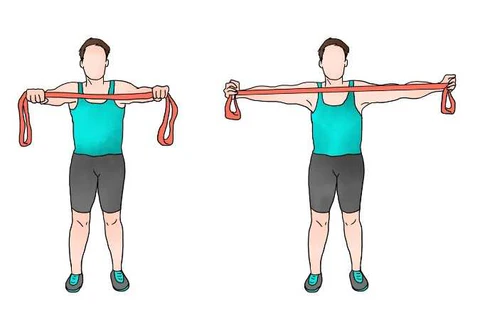
Band pull-aparts are a deceptively simple movement that deliver serious benefits for shoulder health, posture and mobility. This resistance band shoulder warm-up is ideal for prepping your body before pressing workouts, correcting imbalances, or reinforcing good scapular mechanics. It’s one of the most accessible and joint-friendly ways to keep your shoulders feeling strong and mobile.
To perform the exercise, hold a light resistance band with both hands extended in front of you at shoulder height. Keep your arms straight but not locked, and slowly pull the band apart by driving your hands outward, squeezing your shoulder blades together. Pause for a second at full extension, then return to the start with control.
This posterior chain shoulder movement primarily activates the rear deltoids, rhomboids and mid traps. It helps improve scapular retraction and stabilizes the shoulder blades. Key components in maintaining healthy shoulder function. As a rear deltoid band exercise, it’s perfect for balancing out push-heavy routines that overemphasize the front delts and chest.
Because of its simplicity and low risk, band pull-aparts can be used as part of your daily shoulder joint health drill or as a finishing move to reinforce proper movement patterns. It’s also great for postural correction shoulder activation. The exercise is ideal for desk workers, lifters and athletes alike. Focus on high reps, light resistance and strict form for maximum impact.
Shoulder Dislocates
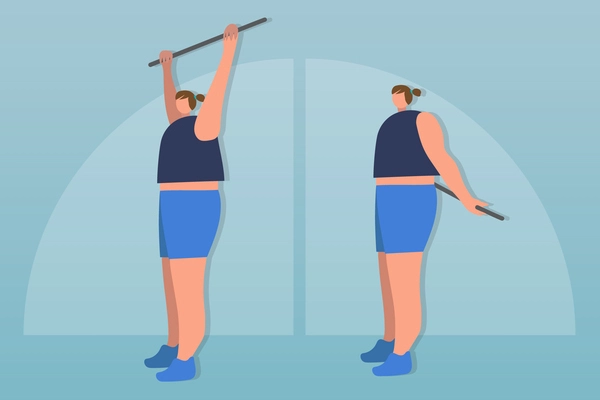
Shoulder dislocates are a classic shoulder flexibility exercise used to improve range of motion, loosen tight muscles and prep the upper body for demanding lifts. Despite the name, there’s no joint damage involved just a controlled mobility drill that works wonders for anyone needing smoother overhead movement.
To perform this drill, grab a PVC pipe, resistance band or broomstick with a wide grip in front of your thighs. Keeping your elbows straight, slowly raise the bar overhead and around behind you until it reaches your lower back, then reverse the motion back to the start. Go slow, and only use a range where your shoulders stay comfortable.
This movement is a mobility drill for overhead lifts, targeting the shoulder joint capsule, rotator cuff, and surrounding stabilizers. It enhances rotator cuff range of motion, prepares the body for pressing exercises, and helps prevent shoulder tightness from building up over time. Athletes who train snatches, overhead presses, or handstands often rely on this movement to stay limber and strong.
Shoulder dislocates with a band or PVC pipe are best used as part of a dynamic shoulder warm-up or active recovery day. Keep your grip wide at first and slowly narrow it as mobility improves. When done regularly, this drill becomes a key tool for maintaining long-term shoulder function and performance.
Tips for an Effective Shoulder Workout Routine
Getting the most out of your shoulder workouts isn’t just about lifting heavier weights, it’s about training smarter. To maximize shoulder training results, you need to think beyond basic movements and consider how you structure your sessions, how often you train, and how well you recover. Shoulders are complex and mobile, which makes them both powerful and vulnerable if not trained with care.
Start every session with a thorough warm-up. Include mobility drills, light activation exercises, and dynamic stretches to prepare the joints and surrounding muscles. This helps prevent common shoulder injuries by increasing blood flow and improving your range of motion before you start pressing or pulling. Skipping this step can lead to shoulder pain and stalled progress down the line.
Structure your routine to hit all three heads of the deltoid—anterior, lateral, and posterior. Many lifters overemphasize front delt work with pressing, but neglect rear delt and side delt activation. For best practices for deltoid growth, combine compound lifts with targeted isolation movements and vary your rep ranges to hit both strength and hypertrophy goals.
Lastly, pay attention to rest and recovery. Muscles grow between workouts, not during them. Allow 48 to 72 hours before hitting shoulders again, and don’t underestimate the importance of sleep, nutrition, and shoulder-specific mobility work. A smart shoulder workout structure balances volume, intensity, and recovery to help you build balanced upper body strength safely and efficiently.
Frequently Asked Questions About Shoulder Exercises
How often should I train shoulders for size and strength?
To see real progress, most people benefit from training shoulders 1 to 2 times per week. This allows enough volume to stimulate muscle growth while giving the joints time to recover. The best shoulder training frequency depends on your split, recovery capacity, and total weekly volume across pushing movements.
How long does it take to recover from a shoulder workout?
Most shoulder workouts require 48 to 72 hours of recovery. Since the deltoids are involved in many compound lifts like bench press and overhead pressing, recovery time after shoulder workout sessions becomes even more critical. Overtraining can lead to joint strain or plateaued growth.
What shoulder exercises are safe for people with shoulder pain?
If you’re dealing with discomfort, focus on safe exercises for shoulder pain like face pulls, band pull-aparts, and landmine presses. These movements build strength and stability without placing excess stress on the joint. Always consult with a medical professional before starting new movements if you're rehabbing an injury.
Can I build shoulders with just dumbbells at home?
Yes, a dumbbell only shoulder workout plan can be highly effective. Movements like seated dumbbell presses, lateral raises, front raises, and rear delt flyes hit all three heads of the deltoid and can be done at home with minimal space. Focus on strict form and progressive overload for continued results.
What exercises strengthen the rotator cuff?
Rotator cuff strengthening for lifters often includes internal and external rotations with resistance bands, face pulls, and shoulder dislocates. Strengthening this small but crucial muscle group improves overall joint function and reduces injury risk.
How can I make my shoulders grow faster?
Combine heavy compound lifts with high-rep isolation work. Incorporate progressive overload, maintain consistent nutrition, and prioritize full recovery. Implementing shoulder muscle growth tips like training all three deltoid heads and mixing intensity levels will help you build stronger, fuller shoulders over time.
Train Smart, Press Strong, and Build Shoulders That Last
Training your shoulders isn’t just about pressing heavy. It’s about building strength, balance and control that supports everything else you do in the gym. A complete shoulder development program includes both compound and isolation movements, targets all three heads of the deltoid, and addresses mobility, stability and endurance.
If you're new to lifting, start with a shoulder exercise routine for beginners that focuses on form and light resistance. Build from there by incorporating more challenging movements like the overhead press or pike push-up. For more experienced lifters, adding functional drills like Turkish get-ups and band work helps protect your joints and support long term shoulder strength.
It’s also important to think about frequency and variety. Training shoulders once or twice a week with different tools; barbells, dumbbells, bands and bodyweight allows you to build well rounded shoulders without overtraining. Switching up angles and tempos keeps the muscles adapting and the progress steady.
No matter your experience level, the key to maximize upper body results lies in a balanced shoulder training approach. Prioritize technique, listen to your body, and stay consistent. Strong, healthy shoulders aren’t built in a day, but with the right plan, they will carry you further than any one rep ever could.

